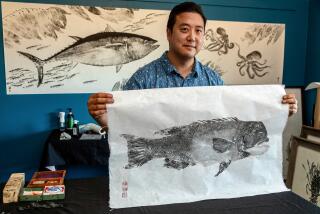Carving Out a Niche in Netsuke Art : Lee Younggren’s Boy Scout whittlings eventually led to precision drilling of the detailed, Japanese-style figures, which the San Juan Capistrano man also collects.
SAN JUAN CAPISTRANO — On the one hand there are Lee Younggren’s netsuke carvings, sculptures of exquisite detail and delicacy that are easily palmed--walnut-sized little worlds of simple line and natural complexity. He has a collection of both original netsukes (pronounced nets-kay), crafted in Japan between the 1600s and the past century and his own made over the past two decades.
On the other hand, there are Younggren’s, um, hands. They’re huge mitts he describes as “basketball hands” that look ill-suited to handling anything more delicate than an ax.
“I think I can say I’m probably the only round-eyed, 6-foot-4 Swede doing netsuke,” said the large-looming 73-year-old. Indeed, there are no more than a dozen other recognized Caucasian netsuke artists in the world.
Younggren, who looks a bit like a wholesome Vincent Price, has had his work turn up in books and magazines, on Japanese TV, in prominent collections and in exhibitions from Los Angeles to Tokyo.
He once was asked to give an exhibition of his carving technique at Pasadena’s Pacific Asia Museum, which he obliged, although he says, “It must have been tedious for people, because in netsuke carving almost nothing happens. It’s a very slow process.”
It takes him about a month to make one, with his work limited to three hours a day by the eye fatigue from wearing the magnifying lenses necessary for the exacting work. His one-a-month schedule is about the same pace as that of modern Japanese masters, although their work is more labor-intensive.
The Asian experts have such an intense devotion to their craft that they still make their own hand tools. “One Japanese carver I spent some time with in Japan sent me some of the raw steel they use, and he said, ‘You will want to temper this yourself, and forge and bend it to do the cutting you want.’ But I’d seen how long it takes to scrape a carving out by hand and figured, ‘The hell with this: I’m going to grind ,’ ” said Younggren, who uses an electric dental drill.
Netsuke is an art form that wouldn’t exist if kimonos had pockets. The carvings are functional, with holes for cords, which would attach to lacquered flasks or purses (netsukes were the toggles that would latch the cords to the kimono belts).
Most of the designs are drawn from nature or Japanese mythology, although there seems no limit to the invention carvers can apply to those forms. Among Younggren’s antique netsukes are a lily pad inhabited by some two dozen crumb-sized frogs piled upon each other, four tigers interlocked in a biting battle, with a baby tiger squirming underneath, and temple Foo dogs with genuine black pearls in their mouths.
Younggren has a particular affection for the fanciful Foos and has made several. He also used the enclosed-pearl idea in a sculpture of a dragon’s paw--made from walrus tusk, water buffalo horn and South Sea black pearl--which he gave a Western twist.
“In Oriental literature the dragon is always looking for the sacred pearl; it’s a symbol of soul,” he said, “This is a dragon that has finally found his. The dragon typically is an imperial symbol. I showed this to Japan’s Prince Takamoto and explained to him that because the imperial dragon has five claws, it’s symbolic that this has four claws, showing that the ordinary man of the world can try to find his soul. He doesn’t have to be royalty.”
Younggren first met Prince and Princess Takamoto in Japan when he’d been invited to view the Imperial netsuke collection in 1990.
“I was honored, I think, because I was an oddity: an American carver of Japanese art. This was right before the coronation (of Emperor Akihito) ,so we were going through barbed wire fences, with choppers circling overhead. They were really guarding the royalty. The prince and princess are an enchanting couple. They love Americans and Europeans because we talk to them, while the Japanese people are just in awe of them.
“Then last year we had a big convention in San Francisco. My wife and I were standing there in the lobby of the Hyatt at Union Square, waiting for a couple of doors to open and here come the prince and princess with a big entourage of Japanese wheels behind them. When they got about 10 feet away they recognized us, and it was all ‘Ah so,’ and shaking hands, which is kind of nice for a little guy from San Juan Capistrano. We got plenty deep bowing then from all their followers who saw them with us,” Younggren said.
Curiously, while the world’s rarities seem to getting bought up by Japan, the big market for netsuke is in the West. “Some of the older rich appreciate and buy the expensive antique ones, but the younger Japanese are busy buying old Levis for $1,000 a pair. I think one reason why I got on so well with the Japanese carvers is we share something: The Japanese don’t buy our work. In my case, it’s like trying to sell an American car to the Japanese,” he said.
Younggren’s carving fixation started in his youth when he’d whittle with a Boy Scout knife, a trusty blade he still has and uses. Following college and Army duty in World War II, he took to wood carving in a big way, beginning with the purchase of a large piece of teak.
“At 3 the next morning my wife was saying, ‘Would you please come to bed?’ I was out there with my Scout knife, an ax and a saw. I guess carving’s something I have to do,” he said. He has no formal art training.
His introduction to netsuke came two decades ago when he and wife Betty were walking through the Pasadena Rose Bowl Swap Meet. He recalled, “A Chinese guy there showed me one, and I called my wife over and said, ‘Give me $60.’ She looked at it and said, ‘forget it.’ ”
Younggren wound up getting it anyway, and he was entranced, although he soon found it was an inferior Hong Kong reproduction, what he and other collectors disparagingly refer to as “airport art.” Once educated, he bought his next one for $200, another for $1,400, and it’s been spiraling upward ever since. It’s become a speculators’ market in the past decade, and certain netsukes now sell for upward of $70,000.
Before retiring, Younggren was a regional director of the Conference Board, a respected business research company. This meant he got to have coffee with lots of Fortune 500 CEOs and also to travel frequently, which allowed him to search for netsukes in such off-markets as Boise, Ida.
He and his wife collect a variety of Asian items, including scrolls, swords, bronzes, jade and wood block prints. The netsukes remain his special love, and he has the advantage that those he can’t buy, he can copy.
Most of the ones he makes, though, are original designs, such as his combination of the dragon-like Kirin body with the head of a Baku, a mythical elephant-nosed creature handy at getting rid of bad dreams. He has just begun shaping it from a rough chunk of walrus tusk in his garage workshop.
Many materials have been used for netsukes, but ivory was the traditional favorite. Even when there was legal, elephant preserve-sanctioned ivory, Younggren had moral qualms about using it. He gets his walrus from Eskimo tribes and also often carves in mountain mahogany and prehistoric Siberian mammoth tusk, which he notes “smells really bad when you’re carving it, like the bottom of (an) anthropological museum.”
With his dental drill, scalpels (gifts from doctor friends) and Scout knife, Younggren has turned out some incredible stuff, such as a fish whose hollow insides are revealed by see-through lattice-like scales and a remarkably detailed tiny tiger’s skull.
“Now a tooth is a tooth in that thing,” he noted, “In the airport art they just go, ‘zip, zip zip, that’s a tooth.’ On these, every tooth is just like a real one in miniature. We do the gum line and everything.”
More to Read
The biggest entertainment stories
Get our big stories about Hollywood, film, television, music, arts, culture and more right in your inbox as soon as they publish.
You may occasionally receive promotional content from the Los Angeles Times.










